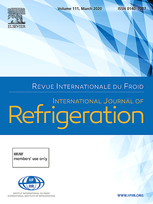
IIR document
Analysis of the novel multi-vane Revolving Vane compressor – Theoretical modelling and experimental investigations.
Author(s) : CHOO W. C., OOI K. T.
Type of article: IJR article
Summary
This paper presents a new variant of the Revolving Vane (RV) compressor, suitable for applications that require high cooling capacity yet low pressure pulsation. By adding supplementary free sliding vanes into the original RV mechanism, the compressor produces multiple discharge cycles per revolution, and hence, it can be configured to produce high volumetric capacity with lower pressure pulsations which are expected to lower the discharge noise level. In this paper, the working principles and the theoretical modelling of the multi-vane RV compressor are presented. A functional prototype has been designed, fabricated, instrumented and tested at the industrial grade compressor performance test bench, using refrigerant R134a as the working fluid. The prototype has operated at 1000 to 2000 rpm and attained pressure ratios of 5.3. The prototype's mass flow rates and volumetric efficiency were successfully measured and correlated with the predictions from numerical simulations. Discrepancies between the predicted and the measured mass flow rates are within ±15%.
Available documents
Format PDF
Pages: 592-603
Available
Public price
20 €
Member price*
Free
* Best rate depending on membership category (see the detailed benefits of individual and corporate memberships).
Details
- Original title: Analysis of the novel multi-vane Revolving Vane compressor – Theoretical modelling and experimental investigations.
- Record ID : 30029166
- Languages: English
- Subject: Technology
- Source: International Journal of Refrigeration - Revue Internationale du Froid - vol. 131
- Publication date: 2021/11
- DOI: http://dx.doi.org/10.1016/j.ijrefrig.2021.08.004
- Document available for consultation in the library of the IIR headquarters only.
Links
See other articles in this issue (95)
See the source
Indexing
-
Performance investigation and design optimizati...
- Author(s) : GU H., YE F., CHEN Y., WU J., LI W., SUNDEN B.
- Date : 2022/10
- Languages : English
- Source: International Journal of Refrigeration - Revue Internationale du Froid - vol. 142
- Formats : PDF
View record
-
Development and experimental validation of a me...
- Author(s) : ISLAM M., NICHOLAS J., BRADSHAW C. R.
- Date : 2023/02
- Languages : English
- Source: International Journal of Refrigeration - Revue Internationale du Froid - vol. 146
- Formats : PDF
View record
-
A Regressive Model for Periodic Dynamic Instabi...
- Author(s) : KUCZYNSKI W., KRUZEL M., CHLISZCZ K.
- Date : 2022/03
- Languages : English
- Source: Energies - vol. 15 - n. 6
- Formats : PDF
View record
-
Un estudio experimental de los ciclos termodiná...
- Author(s) : MONTAGNER G., MELO C.
- Date : 2011/09
- Languages : Spanish
- Source: Frío Calor Aire acondicionado - vol. 39 - n. 439
- Formats : PDF
View record
-
Numerical investigation on indicated power and ...
- Author(s) : PAN X., PAN S., HOU J., ZENG W., XIE J.
- Date : 2022/10
- Languages : English
- Source: International Journal of Refrigeration - Revue Internationale du Froid - vol. 142
- Formats : PDF
View record
